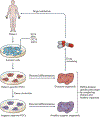Induced pluripotent stem cells in disease modelling and drug discovery
- PMID: 30737492
- PMCID: PMC6584039
- DOI: 10.1038/s41576-019-0100-z
Induced pluripotent stem cells in disease modelling and drug discovery
Abstract
The derivation of induced pluripotent stem cells (iPSCs) over a decade ago sparked widespread enthusiasm for the development of new models of human disease, enhanced platforms for drug discovery and more widespread use of autologous cell-based therapy. Early studies using directed differentiation of iPSCs frequently uncovered cell-level phenotypes in monogenic diseases, but translation to tissue-level and organ-level diseases has required development of more complex, 3D, multicellular systems. Organoids and human-rodent chimaeras more accurately mirror the diverse cellular ecosystems of complex tissues and are being applied to iPSC disease models to recapitulate the pathobiology of a broad spectrum of human maladies, including infectious diseases, genetic disorders and cancer.
Conflict of interest statement
Competing interests
G. Q. D. holds intellectual property relevant to development of cell and drug therapies based on IPSC technology.
Figures



References
-
-
Takahashi K et al. Induction of pluripotent stem cells from adult human fibroblasts by defined factors. Cell 131, 861–872, 10.1016/j.cell.2007.11.019 (2007).
References 1–3 provide the first descriptions of induced pluripotent stem cells from human cells.
-
-
-
Takahashi K & Yamanaka S Induction of pluripotent stem cells from mouse embryonic and adult fibroblast cultures by defined factors. Cell 126, 663–676, 10.1016/j.cell.2006.07.024 (2006).
This is the first description of induced pluripotent stem cells.
-
-
-
Thomson JA et al. Embryonic stem cell lines derived from human blastocysts. Science 282, 1145–1147 (1998).
This paper describes the isolation of human embryonic stem cells.
-
Publication types
MeSH terms
Grants and funding
LinkOut - more resources
Full Text Sources
Other Literature Sources
Medical

